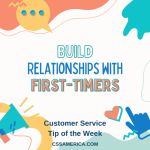 Building customer comfort and confidence in going to your facilities is a process which has a lot of similarities to the technique we train clients on to reduce customer anxiety. From a tactical perspective, when you’re interacting with somebody who is anxious or nervous, you want to get them more comfortable and less worried about their situation or what’s going to happen.
Building customer comfort and confidence in going to your facilities is a process which has a lot of similarities to the technique we train clients on to reduce customer anxiety. From a tactical perspective, when you’re interacting with somebody who is anxious or nervous, you want to get them more comfortable and less worried about their situation or what’s going to happen.
Convey your understanding of their situation, so they realize they’re not a number – instead, they feel you view them as an important individual. Tell them a little bit about yourself and the experience that you’ve had in dealing with similar situations – you’re building their confidence in you. Next, explain a process or what an experience is going to be like. Oftentimes anxiety or worry are about fear of the unknown. By explaining the next steps and the timeframes, your role v. theirs, the unknown becomes known.
“To create customer comfort, make the unknown known
Finally, end with appreciation and positivity. This whole 1-on-1 interaction technique applies to your broader strategy of building customer comfort and confidence.
Here’s the Strategic View: Communicate with them over time to maintain the relationship leading up to their return visit. Provide some empathy of their situation, and detail what you and your organization are already doing to ensure that your employees and – most importantly – the customers themselves are safe and healthy. Explain all the steps that you’re going to take next to prepare to provide a great (and safe) experience. And thank them in advance for their return and their trust in you.
Build comfort and confidence from your customers by leaning on our successful technique for reducing customer anxiety and worry.














 Jack Nicklaus may have been the greatest golfer ever. Many think that Arnold Palmer was the most important golfer of the 20th century. These two greats were contemporaries, so they became competitors and friends all at once. And when somebody who is one of the greatest of all time gives you advice, you should take it, right?
Jack Nicklaus may have been the greatest golfer ever. Many think that Arnold Palmer was the most important golfer of the 20th century. These two greats were contemporaries, so they became competitors and friends all at once. And when somebody who is one of the greatest of all time gives you advice, you should take it, right? Becky was laying in her hospital bed and staring at the whiteboard on the wall. It had a room number, the room’s phone number, and the date. It had the pictures of the pain scale, with happy-to-sad faces and ratings from 0-10. It noted when the last meds were administered and when the next meds were scheduled. It talked about goals for the day and key next steps. And it mentioned what diet she was on and what activities and precautions applied to her.
Becky was laying in her hospital bed and staring at the whiteboard on the wall. It had a room number, the room’s phone number, and the date. It had the pictures of the pain scale, with happy-to-sad faces and ratings from 0-10. It noted when the last meds were administered and when the next meds were scheduled. It talked about goals for the day and key next steps. And it mentioned what diet she was on and what activities and precautions applied to her. 






